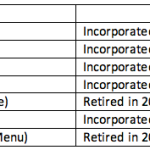Over the past couple of weeks I have been discussing some of the insights gained from our first look at the proposed rule for the second stage of the meaningful use program. Of course this is not a “Toy Story,” but today let’s explore some of the features within the NPRM that may impact us in 2015 and beyond.
Future Stages
The Stage 2 NPRM provides a glimpse into the future of the program. The table below clarifies the intention to require providers to sequentially face the progressive stages of meaningful use. With the exception of those who demonstrated meaningful use in 2011, all providers are expected to face the stage 1 objectives for two years, followed by two years of the stage 2 objectives and then two years of the stage 3 objectives.
The body of the NPRM makes a single reference to the “TBD” in the table: “If there will be a Stage 4 of meaningful use, we expect to update this table in the rulemaking for Stage 3.” As you may recall, the Medicare path to meaningful use is the most common path for nephrologists. According to data presented by the government, every nephrologist who attested in 2011 took the Medicare path. Unlike the Medicaid path to meaningful use, the Medicare path has a tight time restriction. 2014 is the last year to begin if you intend to receive the incentive.
What does this mean for nephrologists? In effect the table above is conveying two types of information: 1) for those starting in 2014 or earlier, it defines what stage of meaningful use you must meet to receive the incentive; 2) for those starting later, it defines what stage of meaningful use you must meet in order to avoid the “adjustment.”
Reach for the Sky
The adjustment of course is the penalty levied against the provider’s Medicare Part B physician fee schedule (PFS). If a provider is deemed not to be a meaningful user, he or she will face a 1% reduction in their Medicare PFS in 2015. The penalty rises to 2% in 2016 and 3% in 2017. The Stage 2 NPRM provides a view into the method by which CMS intends to identify whom to penalize.
Essentially CMS has taken a page from the eRx incentive program playbook. Providers who do not demonstrate meaningful use in 2013 will face the adjustment in 2015. That’s right, the NPRM basically states the adjustment period is surveying physician behavior two years prior to the penalty. There are exceptions proposed including:
- First time participants can demonstrate meaningful use in 2014, and if they attest prior to October 1, 2014, they will not face the penalty in 2015.
- New providers (fresh out of training) are protected from the penalty for two years.
- Providers in rural areas without sufficient access to the internet will be excluded from the penalty.
- Providers facing extreme circumstances (eg, Hurricane Katrina) will be excluded from the penalty.
ONC is also proposing additional exclusions related to telemedicine, lack of control of EHR purchase decisions and other topics not generally applicable to the practice of nephrology. As I mentioned last week, the conversations we have been having about Stage 2 are based on what is proposed. The public comment period ends May 7, 2012, and later this summer we can expect to see the final rule for Stage 2.
Woody and Buzz Lightyear have provided us with years of entertainment in the form of multiple sequels to the original movie. CMS and ONC have teamed up to write a different type of story. Toy Story is far more entertaining, but we need to pay close attention to the meaningful use story as Stage 2 unfolds over the next few months. In the meantime, leave us a comment and let us know what you think about this evolving story.



RG says
In the book “Drive” that you suggested, he talks about the carrot and the stick. It looks like CMS has read this book too. He says that carrot and stick do not work if the project is fun, and creative (it actually works in reverse). But, the carrot and stick does work for mundane tasks. Thus, I think the government has concluded that going electronic meets the latter criteria. Given how many people are going electronic now, I think believe they are correct in their reasoning. I am impressed with the way the government has structured this program. If the government had said, go electronic in 2011, or you will have a fine of $18,000—many more people would have gone electronic that year. But if the government said “you get a bonus of $18,000 if you go electronic” in 2011, most people would delay. But these affect one’s income by that amount in either case. They must have a psychologist up there making these decisions because they seem to really be perfect.